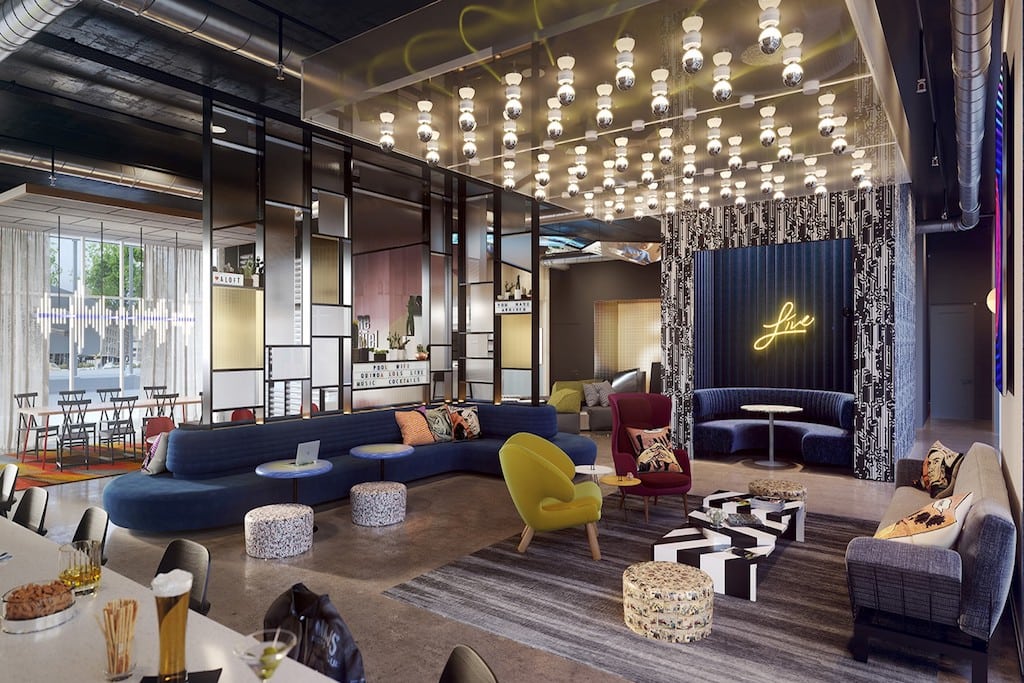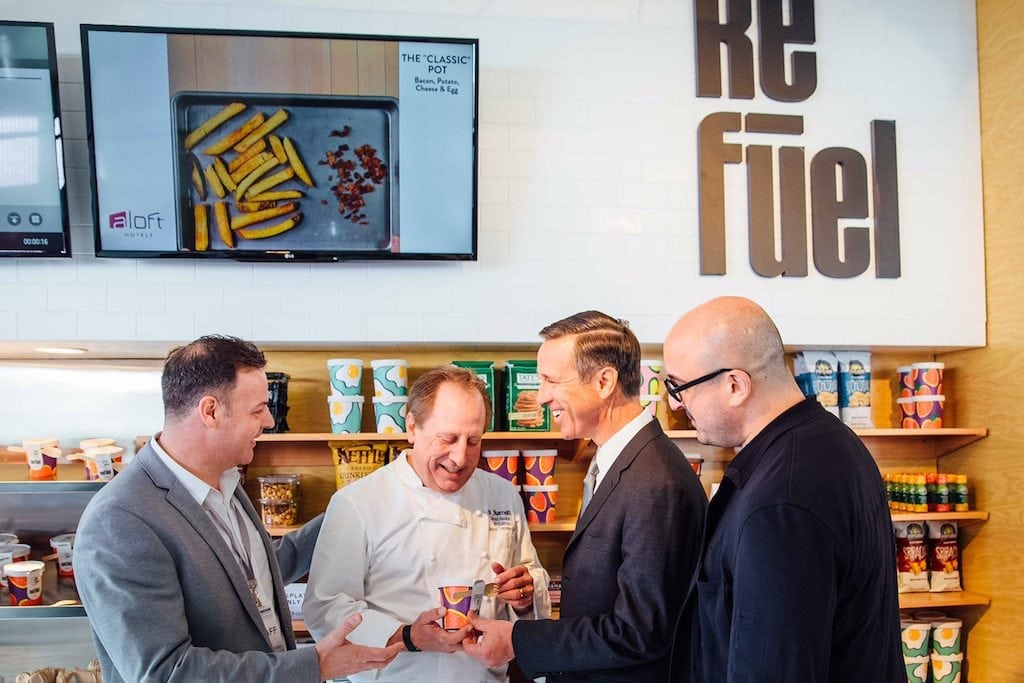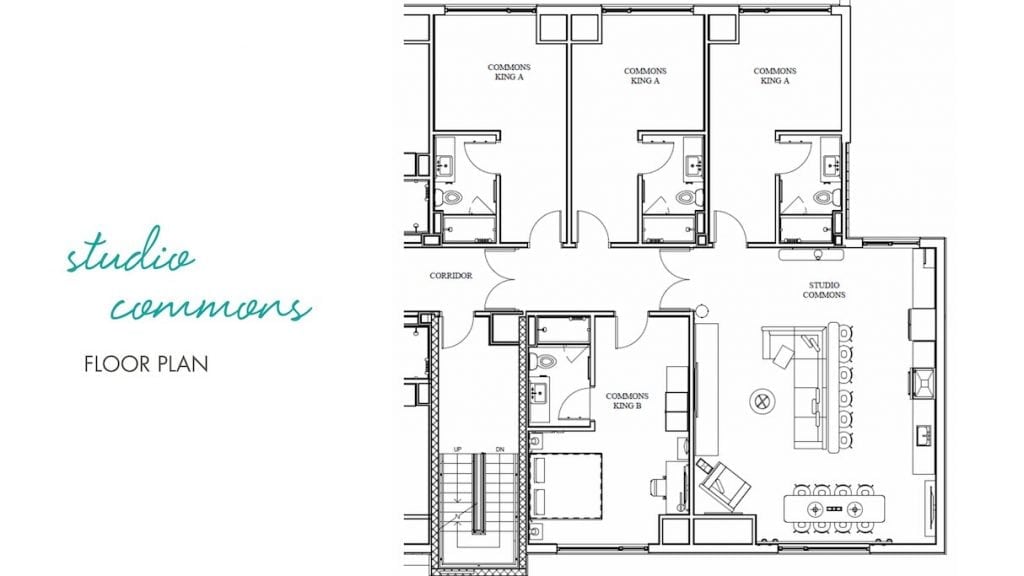Marriott's Revamp of Aloft and Element Points to the Future of Select Service Hotels

Skift Take
After Marriott purchased Starwood Hotels & Resorts for $13.3 billion in September 2016, a tough question emerged: What would Marriott do with all those 30 brands in its now expanded portfolio?
Whether the company needs 30 brands is another issue, and one that's widely debated in the hospitality industry.
However, a little more than one year after the deal closed, we're beginning to see what Marriott has done with those 11 Starwood brands it inherited, and one of the best examples of that is the company's efforts to try to reinvigorate the Aloft and Element brands.
Investors and owners are still keenly interested in both of the categories these brands represent — select service and extended stay — and Marriott knows Aloft and Element haven't scaled up to their potential. Marriott has opted to focus on revamping these brands while the cycle still has legs.
Aloft and Element owners essentially told Marriott that the biggest problems with both brands are construction costs, as well as property cost models. Marriott's solution was to focus on smarter room designs and more streamlined food-and-beverage programs for both Aloft and Element, as well as a new floor model for Element that would appeal to groups.
Here's a detailed look at the evolution of Aloft and Element, and what it says about the future of lifestyle extended stay and select service hotels.
Pioneers in Lifestyle Select Service and Extended Stay
When Starwood launched Aloft in 2005, followed shortly by Element in 2006, the two brands were uniquely positioned for their time.
Aloft, marketed as "a vision of W Hotels," Starwood's wildly successful boutique twist on the traditional full-service hotel, was meant to follow a similar trajectory, but for the then very nascent, but growing select-service space. At a time when the boutique hotel movement was in full swing, tech-driven Aloft adopted a design aesthetic that was, at the time, very forward-looking — perhaps too much so. Think concrete floors and bright, vivid hues.
Element, by contrast, capitalized on the "eco-friendly" movement that was gaining momentum in the U.S. and worldwide; it required LEED certification, something the brand no longer mandates. It was an extended stay product, geared toward longer-stay travel, and it borrowed its design aesthetic from sister brand Westin.
"They were very innovative in their early launches," Mark Skinner, a hospitality industry expert and partner in The Highland Group said of the two brands. "Aloft was more [innovative] in its design and was one of the early lifestyle brands. Element was also creatively designed" and was "very, very high quality."
Ben Seidel, president and CEO of Ocean City, Maryland-based hotel management firm Real Hospitality Group, said what originally drew him to open his first Aloft property "was the hype." He opened his first Aloft in 2009-2010 in Brooklyn, New York, next to a Sheraton, which his company also manages.
Today, Seidel is president of Marriott's Owners Council for the Aloft brand. He has four Aloft hotels in his portfolio, with another Aloft and his first Element property on the way.
The Great Recession of 2008, however, took its toll and "it was hard to get off the ground something new that was coming to the industry for the first time," he said.
At first, Seidel said, some customers weren't sure about the Aloft experience. "Because of how strange the concept was for your typical frequent stay and loyal Starwood customer," it could be a bit of a challenge, he said. "But once they got there they liked it."
Seidel said he sees more repeat business at the Aloft New York Brooklyn than at the Sheraton Brooklyn New York Hotel next door, and the guests staying at the Aloft range from "young and old to everything in between."
Although Aloft and Element were creative and unique when they debuted, they never grew to scale, said former Starwood CEO Frits van Paasschen, who led the company from 2007 to 2015. In the fall of 2016, just before the deal closed, van Paasschen told Skift, "With the exception of Sheraton, Starwood's other brands are still sub-scale. With the proper investment, they have plenty of room to grow."
Their growth pace lagged other brands.
"They didn't grow at the pace of some of the other brands," said Skinner. "The perception with Element was that it cost too much to build. Aloft was initially aimed at urban locations, which is limiting, and has subsequently moved into suburban locations."
By the time Marriott purchased Starwood, there were 116 Aloft hotels and only 23 Element properties around the world, with 150 Alofts and 73 Elements in the global pipeline. In contrast, Marriott's extended stay Residence Inn brand has nearly 900 properties in the U.S. alone.
Today, there are 135 Aloft hotels open and 32 Element hotels, and another 137 Aloft hotels and 76 Element hotels are in the pipeline. How they got to this place demonstrates where the lifestyle select-service and extended stay lodging segments are headed.

Marriott CEO Arne Sorenson (second from right) tested Aloft's new food-and-beverage program at the company's Innovation Lab last year. Source: Marriott International
The Innovation Lab Approach
As soon as Marriott and Starwood signed the deal, Marriott's teams immediately went to work on integrating the Starwood brands. They chose the Aloft and Element brands as one of the first targets, said Eric Jacobs, Marriott's chief development officer of select service and extended stay brands in North America.
The primary reason why Marriott decided to focus on these brands? "Because the cycle is still very hot, it was very important for us to jump quickly into these two brands when investor interest was still high," Jacobs said.
Another reason was that because both brands had limited footprints, Jacobs said, it would be "easier to make changes," as opposed to trying to reinvigorate a brand as large as Sheraton, which has 444 hotels globally.
Both of these brands' categories — select service and extended stay — remain favorites among investors and owners. Marriott's peers are launching new select-service brands and seeing success with their existing limited service brands. Skinner said, "The largest growth in development in terms of new rooms is in the select-service segment."
Marriott's own 2017 numbers demonstrate the popularity of select-service lodging among owners and developers. It signed a record 578 contracts for its 11 select-service brands, 158 contracts of which were in the Asia-Pacific region. In North America, it opened 270 select-service hotels and signed 420 contracts last year.
The extended stay market is seeing record levels of demand and occupancy levels, despite the fact that its inventory, at least in the U.S., continues to rise. Still, there's plenty of room in both spaces for the industry to grow, Skinner said. "Only 8 percent of the rooms, about 50,000, in the U.S. are extended stay right now," he said.
To begin work on scaling up these two brands, Marriott held franchise advisory council meetings with Aloft and Element franchisees like Seidel, and taking their feedback and building out prototypes from that input to put on display in what Marriott dubbed its Innovation Lab. Marriott exhibited the freestanding, tent-like structure at last year's Americas Lodging Investment Summit (ALIS) conference in Los Angeles, just outside the conference hotel, and it was open to hotel owners, investors, and the general public.
Owners essentially told Marriott that the biggest problems with both brands related to the cost of construction, as well as property cost models. Marriott's solution was to focus on smarter room designs and more streamlined food-and-beverage programs for both Aloft and Element, as well as a new floor model for Element that would appeal to groups.
"What we heard from owners and developers, in particular, at ALIS last year, was around design and making sure that the design is not too trendy but really different at the same time," said Toni Stoeckl, global brand leader and vice president of Marriott's select brands. "The ease of building a room is very important, and the original designs for both brands weren't as easy to construct. In order to grow the brands, they need to be more flexible in how that layout comes to life, especially in products like conversions."
Stoeckl, who was at Starwood for eight years before joining Marriott in 2009, knew both brands well.
Another part of both brands' models that required improvements was their respective food-and-beverage programs. Jacobs said Aloft customers were "confused" by Aloft's grab-and-go market — they didn't know how to pay for their items in some instances — and Element's food offerings weren't aligned with the brand's wellness concept.
At ALIS, Marriott introduced a digital kiosk where guests could easily order their meals in colorful "pots." Element's breakfast options also got a healthy makeover.
With the new Aloft food-and-beverage program, Seidel said, "you're not inventorying tremendous amounts of food. You're not employing large numbers of staff. The equipment originally specified for Aloft has not been modified, which is very fair to us owners. The redesign of the lobby just makes flow a lot more organized, too. The payment system is not being done at front desk anymore, so front desk agents don't have to deal with handling those purchases."

A floor plan for Element's new Studio Commons concept shows multiple guest rooms that share a common living and kitchen area. Source: Marriott International
And for Element, Marriott debuted a new guest room concept, called Studio Commons, that remakes entire floors into more communal spaces. Instead of having multiple standard extended stay rooms, each with their own kitchenette, these floors have four guest rooms that share a common area that contains a kitchen, dining area, and lounge space.
Element owners can now build some of their rooms without requiring a kitchenette, lowering costs and adding some flexibility in the types of guests they might attract, including leisure and business groups.
Seidel, for one, is taking more of a wait-and-see approach to see if those new communal rooms will be a success.
"I want to see how it's perceived," he said. "I can't say I like it or don't like it. I see that kind of concept in a property that's more of a group hotel." he said.
Seidel, however, wonders if these rooms might pose some challenges. "How can I guarantee that room pattern will still be available when they check in? It's like with connecting rooms. If a certain guest decides to extend his or her stay a day or two, that can be a problem in delivering connected rooms for another customer."
Skinner said Marriott has "value-engineered" these brands, and while he doesn't have a strong opinion about its work on Aloft, he said the quality of the Element brand "hasn't been brought down at all. Clearly, there's been increased developer interest in these two brands and at least part of that can be attributed to Marriott."
Jacobs and Stoeckl said that all of the prototypes presented last year, with some adjustments following owner and customer feedback, have now been incorporated into both brands. The new designs and food-and-beverage programs are being implemented in a number of hotels this year, and will be in all new Aloft and Element projects going forward.
In addition to trying to make these brands more cost effective for owners and developers, Marriott's changes to Aloft and Element also seemingly reflect what guests want in their hotel experiences today: efficiency, healthier options, more flexibility, and the ability to better accommodate group travel, among them.
As Marriott continues its work on integrating Starwood's brands, and striving to ensure that 30 of its brands thrive, the ability to distinguish and make each more appealing to consumers and owners, gets even more crucial.
"With 30 brands now, we have to be really good at what we do," Jacobs said. "In the old days, you could put out a brand and your objective was how to appeal to broadest customer base that I can. Today's consumer is so specific about what he or she chooses, and because of our portfolio, we can also be very specific in how we target customers and be really thoughtful about things.
"If you give me a site in Cupertino, California, I can make a business case for any one of the 30 brands, but I need to be really smart about who's traveling today and what's the right brand for that location, from a guest perspective, and for our owners."




